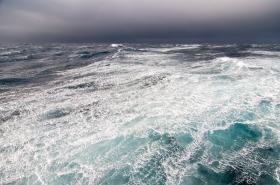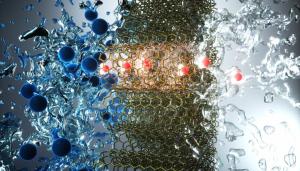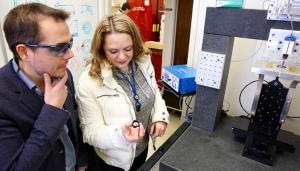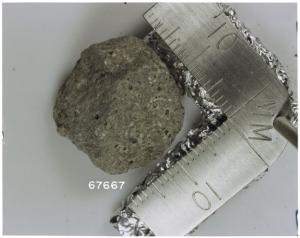LAB REPORT
Science and Technology Making Headlines
Oct. 2, 2020


LLNL’s Monique Warren has been named an 'agent of change' by Diablo Magazine.
An agent of change
If there was ever a year to make a difference, 2020 was it. Diablo Magazine recently celebrated 17 people who — in the face of challenges and crises of all kinds — took risks, broke new ground and found ingenious answers to some of today’s most urgent issues.
Among the candidates is Lawrence Livermore’s Monique Warren. She joined LLNL in 2014 as an intern. Today, the Stockton native is on the forefront of the LLNL’s efforts to protect one of our greatest natural resources: water. Warren works to ensure that the water we use stays safe and clean by analyzing and designing technologies for groundwater remediation, “which is a fancier way of saying groundwater cleanup,” she said.
Though she’s only in her 20s, Warren has already achieved a remarkable level of success — and she wants to ensure that young people have access to the same opportunities she had. “I am where I am, at least partially, because of the STEM outreach programs I participated in as a kid,” she said.
Warren also wants to make “sure the seats at the table are filled with people of all different backgrounds and experiences,” she said. She helps lead the African-American Body of Laboratory Employees, an employee resource group at the Livermore Lab. “It’s difficult to frequently be in rooms where no one looks like you,” she added. “I’ve had to learn to embrace what makes me different and bring my full perspective with me into those rooms.”

New research shows that mixing of the world’s oceans is slowing down.
Filling a void
The layers of the world’s oceans aren’t mixing like they used to due to climate change, potentially speeding up how fast the planet will warm in the coming decades. This new finding, contained in in a recent study, finds that the reduction in the mixing of ocean layers is piling up warm water near the surface while cutting back on the circulation of cold, deep water.
Paul Durack, a research scientist at Lawrence Livermore National Laboratory who has published studies on climate change’s effects on ocean currents, said the study “fills a void” in the scientific literature by quantifying the rate of change. But, he said, the new estimates may still be too low.
“I would not be surprised if this study underestimates the observed change,” he said. Durack was not involved in the new study.

An artist’s view of small-diameter carbon nanotubes that pass through water molecules (red and white) and reject ions (blue). Small-diameter nanotubes can enable advanced water desalination technologies. llustration concept: A. Noy, T. A. Pham, Y. Li, Z. Li, F. Aydin
A drink of fresh water
As water scarcity becomes more common and communities start running out of cheap available water, they need to supplement their supplies with desalinated water from seawater and brackish water sources.
Lawrence Livermore National Laboratory researchers have created carbon nanotube pores that are so efficient at removing salt from water that they are comparable to commercial desalination membranes. These tiny pores are just 0.8 nanometers (nm) in diameter. In comparison, a human hair is 60,000 nm across.
Biological water channels, also known as aquaporins, provide a blueprint for the structures that could offer increased performance. They have an extremely narrow inner pore that squeezes water down to a single-file configuration that enables extremely high water permeability, with transport rates exceeding 1 billion water molecules per second through each pore.


James Lewicki, a materials scientist/polymer chemist at the Lawrence Livermore National Laboratory, and his team devised a practical AM process to make tunable aerospace-grade, short carbon fiber-reinforced thermoset composites.
On the wings of change
Lawrence Livermore materials scientist/polymer chemist James Lewicki is “really into 3D printing” so he has devised a practical additive manufacturing process to make aerospace-grade, short carbon fiber-reinforced thermoset composites and tune the materials for desired physical properties.
“In its current form, I would say the technology is suitable for high-volume, small and medium-size components — complicated parts that need to be light weight — that would be difficult to manufacture conventionally,” said Lewicki, director of the quantitative polymer aging and degradation laboratory at LLNL. “However, if you want to look ahead there are ways to make the technology large-format.”
Lewicki’s technology uses direct ink writing, in which a paste-like material is extruded from a micro-nozzle onto a print platform and retains its shape without relying on solidification or drying. The printer has control over the high aspect ratio fiber’s orientation in three dimensions and, using computational design optimization, can orient the fibers in each of the printed part’s layers to achieve desired strength and stiffness, as well as thermal and electrical conductivity properties, singly or in combination, that are superior to randomly ordered carbon fibers.
To date, the largest part printed on Lewicki’s printer is about 49 feet 3 inches, although the machine is capable of build volumes on the order of 656 feet 3 inches. “I would love to print an aircraft wing but that’s years away and would require a partner,” Lewicki said.


An ancient rock fragment collected at North Ray crater during Apollo 16. Photo courtesy of NASA/JSC.
Many moons ago
Knowing the age of a rock or suite of rocks is very helpful in understanding geologic history. Geochronology — the science of using the isotopic signatures in a rock to determine its age — has been used for more than 50 years to decipher the sequence of lunar rock formation and the evolution of the moon.
A group of scientists at Lawrence Livermore National Laboratory, led by Lars Borg, reanalyzed one of these rocks (part of Apollo 16 sample 67667) using more modern techniques to verify the previously derived age.
The outcome of the new analysis was an isotopic age much older than previously determined and instead consistent with many other magnesium (Mg)-suite samples. This newly determined age strongly suggests Mg-suite magmatism was confined to a relatively short interval of about 20 million years about 4.3 billion years ago.
The Mg-suite rocks did not form by the same method as the other crustal rocks and might have formed during a density-driven overturn event during or shortly after solidification of the lunar magma ocean. These findings argue for a geologically complex moon where lunar crustal formation occurred via different magmatic sources and methods over a short period of time.





